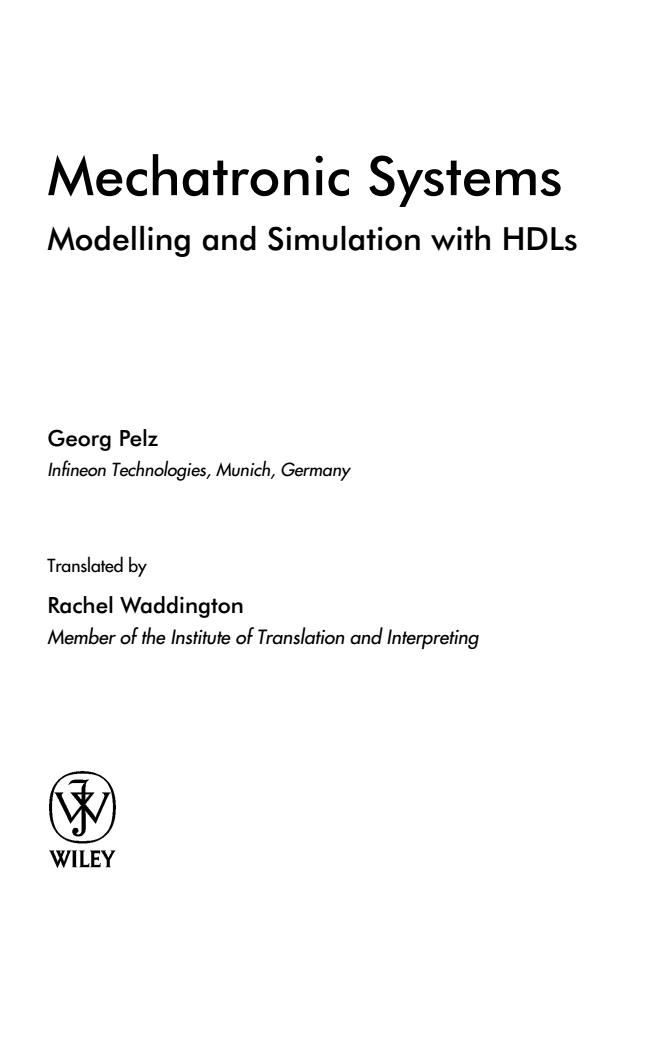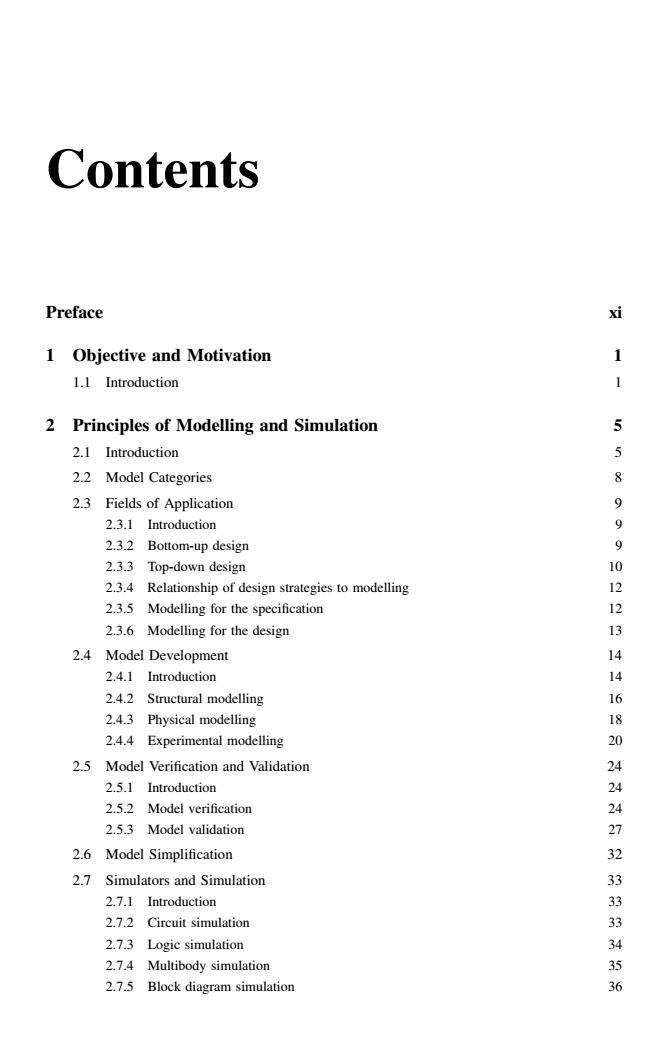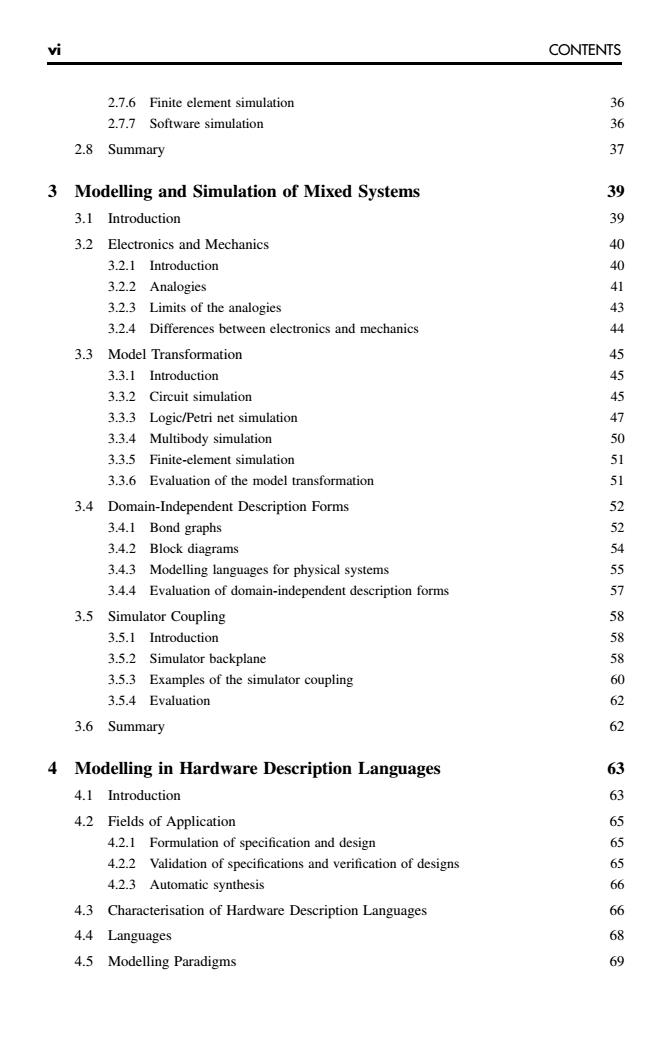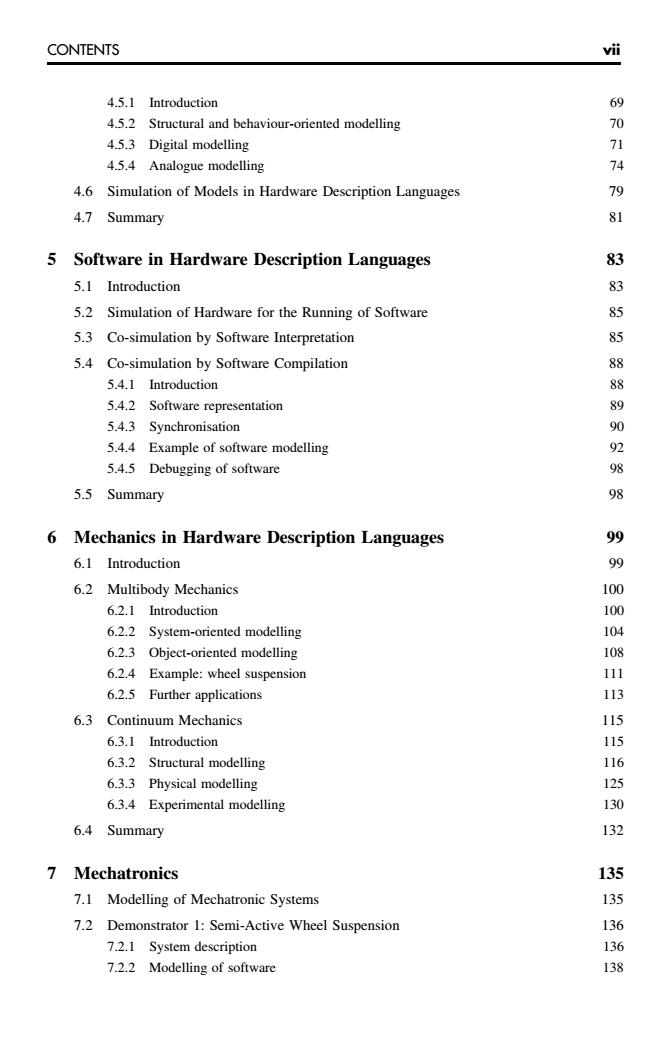
WILEY mechatronic systems modelling and simulation with HDLs GEORG PELZ

Mechatronic Systems Modelling and Simulation with HDLs Georg Pelz Infineon Technologies,Munich,Germany Translated by Rachel Waddington Member of the Institute of Translation and Interpreting WILEY
Mechatronic Systems Modelling and Simulation with HDLs Georg Pelz Infineon Technologies, Munich, Germany Translated by Rachel Waddington Member of the Institute of Translation and Interpreting

Contents Preface 1 Objective and Motivation 1.1 Introduction 1 2 Principles of Modelling and Simulation 5 2.1 Introduction 2.2 Model Categories 2.3 Fields of Application 2.3.1 Introduction 2.3.2 Bottom-up design 2.33 Top-down design 10 2.3.4 Relationship of design strategies to modelling 2.3.5 Modelling for the specification 2.3.6 Modelling for the design 1213 2.4 Model Development 14 2.4.1 Introduction 2.4.2 Structural modelling 16 2.4.3 Physical modelling 2.4.4 Experimental modelling 2.5 Model Verification and Validation 2.5.I Introduction 02444 2.5.2 Model verification 2.5.3 Model validation 2.6 Model Simplification 72 2.7 Simulators and Simulation 33 2.7.1 Introduction 2.7.2 Circuit simulation 33 2.7.3 Logic simulation 2.74 Multibody simulation 2.7.5 Block diagram simulation 36
Contents Preface xi 1 Objective and Motivation 1 1.1 Introduction 1 2 Principles of Modelling and Simulation 5 2.1 Introduction 5 2.2 Model Categories 8 2.3 Fields of Application 9 2.3.1 Introduction 9 2.3.2 Bottom-up design 9 2.3.3 Top-down design 10 2.3.4 Relationship of design strategies to modelling 12 2.3.5 Modelling for the specification 12 2.3.6 Modelling for the design 13 2.4 Model Development 14 2.4.1 Introduction 14 2.4.2 Structural modelling 16 2.4.3 Physical modelling 18 2.4.4 Experimental modelling 20 2.5 Model Verification and Validation 24 2.5.1 Introduction 24 2.5.2 Model verification 24 2.5.3 Model validation 27 2.6 Model Simplification 32 2.7 Simulators and Simulation 33 2.7.1 Introduction 33 2.7.2 Circuit simulation 33 2.7.3 Logic simulation 34 2.7.4 Multibody simulation 35 2.7.5 Block diagram simulation 36

i CONTENTS 2.7.6 Finite element simulatior 36 2.7.7 Software simulation 3 2.8 Summary 3 Modelling and Simulation of Mixed Systems 39 3.1 Introduction 39 3.2 Electronics and Mechanics 40 3.2.1 Introduction 3.2.2 Analogies 3.2.3 Limits of the analogies 43 3.2.4 Differences between electronics and mechanics 3.3 Model Transformation 3.3.1 Introduction 3.3.2 Circuit simulation 3.3.3 Logic/Petri net simulation 3.3.4 Multibody simulation 3.3.5 Finite-element simulation 0 3.3.6 Evaluation of the model transformation 3.4 Domain-Independent Description Forms 3.4.1 Bond graphs 3.4.2 Block diagrams 24 3.4.3 Modelling languages for physical systems 3.44 Evaluation of domain-independent description forms 57 3.5 Simulator Coupling 58 3.5.1 Introduction 3.52 Simulator backplane 35.3 Examples of the simulator coupling 60 3.5.4 Evaluation 3.6 Summary 4 Modelling in Hardware Description Languages 4.1 Introduction 63 4.2 Fields of Application 65 4.2.1 Formulation of specification and design 4.22 Validation of specifications and verification of designs 4.2.3 Automatic synthesis 4.3 Characterisation of Hardware Description Languages 4.4 Languages 68 4.5 Modelling Paradigms 69
vi CONTENTS 2.7.6 Finite element simulation 36 2.7.7 Software simulation 36 2.8 Summary 37 3 Modelling and Simulation of Mixed Systems 39 3.1 Introduction 39 3.2 Electronics and Mechanics 40 3.2.1 Introduction 40 3.2.2 Analogies 41 3.2.3 Limits of the analogies 43 3.2.4 Differences between electronics and mechanics 44 3.3 Model Transformation 45 3.3.1 Introduction 45 3.3.2 Circuit simulation 45 3.3.3 Logic/Petri net simulation 47 3.3.4 Multibody simulation 50 3.3.5 Finite-element simulation 51 3.3.6 Evaluation of the model transformation 51 3.4 Domain-Independent Description Forms 52 3.4.1 Bond graphs 52 3.4.2 Block diagrams 54 3.4.3 Modelling languages for physical systems 55 3.4.4 Evaluation of domain-independent description forms 57 3.5 Simulator Coupling 58 3.5.1 Introduction 58 3.5.2 Simulator backplane 58 3.5.3 Examples of the simulator coupling 60 3.5.4 Evaluation 62 3.6 Summary 62 4 Modelling in Hardware Description Languages 63 4.1 Introduction 63 4.2 Fields of Application 65 4.2.1 Formulation of specification and design 65 4.2.2 Validation of specifications and verification of designs 65 4.2.3 Automatic synthesis 66 4.3 Characterisation of Hardware Description Languages 66 4.4 Languages 68 4.5 Modelling Paradigms 69

CONTENTS 4.5.1 Introduction 4.5.2 Structural and behaviour-oriented modelling 4.5.3 Digital modelling 4.5.4 Analogue modelling 4.6 Simulation of Models in Hardware Description Languages 4.7 Summary 81 5 Software in Hardware Description Languages 83 5.1 Introduction 5.2 Simulation of Hardware for the Running of Software 5.3 Co-simulation by Software Interpretation 85 5.4 Co-simulation by Software Compilation 88 5.4.1 Introduction 5.4.2 Software representation 5.4.3 Synchronisation 90 5.4.4 Example of software modelling 92 5.4.5 Debugging of software 55 Summary 98 6 Mechanics in Hardware Description Languages s9 6.1 Introduction 6.2 Multibody Mechanics 100 6.2.1 Introduction 100 6.2.2 System-oriented modelling 6.2.3 Object-oriented modelling 6.2.4 Example:wheel suspension 6.2.5 Further applications 113 6.3 Continuum Mechanics 1 6.3.1 Introduction 6.3.2 Structural modelling 6.3.3 Physical modelling 125 6.3.4 Experimental modelling 130 6.4 Summary 132 7 Mechatronics 135 7.1 Modelling of Mechatronic Systems 135 7.2 Demonstrator 1:Semi-Active Wheel Suspension 136 7.2.1 System description 136 7.2.2 Modelling of software 138
CONTENTS vii 4.5.1 Introduction 69 4.5.2 Structural and behaviour-oriented modelling 70 4.5.3 Digital modelling 71 4.5.4 Analogue modelling 74 4.6 Simulation of Models in Hardware Description Languages 79 4.7 Summary 81 5 Software in Hardware Description Languages 83 5.1 Introduction 83 5.2 Simulation of Hardware for the Running of Software 85 5.3 Co-simulation by Software Interpretation 85 5.4 Co-simulation by Software Compilation 88 5.4.1 Introduction 88 5.4.2 Software representation 89 5.4.3 Synchronisation 90 5.4.4 Example of software modelling 92 5.4.5 Debugging of software 98 5.5 Summary 98 6 Mechanics in Hardware Description Languages 99 6.1 Introduction 99 6.2 Multibody Mechanics 100 6.2.1 Introduction 100 6.2.2 System-oriented modelling 104 6.2.3 Object-oriented modelling 108 6.2.4 Example: wheel suspension 111 6.2.5 Further applications 113 6.3 Continuum Mechanics 115 6.3.1 Introduction 115 6.3.2 Structural modelling 116 6.3.3 Physical modelling 125 6.3.4 Experimental modelling 130 6.4 Summary 132 7 Mechatronics 135 7.1 Modelling of Mechatronic Systems 135 7.2 Demonstrator 1: Semi-Active Wheel Suspension 136 7.2.1 System description 136 7.2.2 Modelling of software 138